CHICAGO – In anticipation of the scariest week of the year, HollywoodChicago.com launches its 2024 Movie Gifts series, which will suggest DVDs and collections for holiday giving.
Interview: Drew Goddard Gives Tour of His ‘Cabin in the Woods’
CHICAGO – You may not know Drew Goddard’s name but you almost certainly know his work. Or at least you should. He’s one of the most influential and important TV writers of the last several years on key episodes of “Buffy the Vampire Slayer,” “Angel,” “Alias,” and “Lost.” He co-wrote the fantastic new horror thriller “The Cabin in the Woods” with the legendary Joss Whedon and the film serves as his stellar directorial debut (he also wrote “Cloverfield” for you non-TV folk).
The smart, fun, energizing “The Cabin in the Woods” is one of the best horror films in years, something we’ll get into in more depth with our review later this week but let’s start with a wonderful interview with the creative man behind it. Every once in awhile, an interview feels shorter than a journalist wishes it had been — I could have spoken to Mr. Goddard for hours. And hope I get the chance to again soon.
The interview started off with a little bit of fan worship as I made my geek cred clear by raving about the quality of the “Buffy” episode “Conversations with Dead People” and the “Lost” episode “The Man From Tallahassee,” two of the best hours of television in the last twenty years and both written by Goddard. I told him as much, to which he responded…
DREW GODDARD: You know what’s interesting about those two episodes? Both of them were written and conceived over a period of two days. “Conversations” we were SO behind. Joss [Whedon], Marti [Noxon], and Jane [Espenson] — we did it over two days. “Man” was the same way. That’s what happens in TV sometimes. I started to notice that sometimes having too much time is your enemy.
HOLLYWOODCHICAGO.COM: I always work better under deadline.
GODDARD: I don’t like it. It’s not good for your sanity. But you sometimes do your best work.
HOLLYWOODCHICAGO.COM: What do you think IS your best work?
GODDARD: That’s a good question. I have a special fondness for “Selfless,” the first “Buffy” episode I did, but that might just be because it was the first. It was definitely…I remember writing the very first scene in which Anya comes home talking to a troll in subtitled Swedish and I just remember thinking, “This is a perfect scene to launch my career. This is what I want — a domestic dispute among ridiculousness.” And that’s carried over [to the rest of my career]. Even into “Cabin” — high genre mixed with mundane, real-life situations.
HOLLYWOODCHICAGO.COM: And that was part of the genius of “Buffy” — bringing realism to the unreal.
GODDARD: Right.
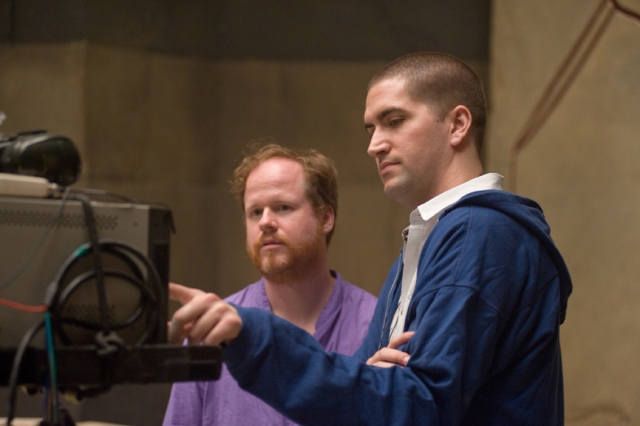
The Cabin in the Woods
Photo credit: Lionsgate
HOLLYWOODCHICAGO.COM: OK. I know you’ve talked about this a ton but it has to come up — “The Cabin in the Woods” sat on the shelf over two years. During that time, are you frustrated? Do you worry it won’t see the light of day?
GODDARD: I never worried about that. When you saw things like James Bond and “The Hobbit” also getting delayed [due to MGM’s financial difficulties], we felt like we were in good company. “This isn’t about us. This is about much bigger problems.” There’s comfort in that. It isn’t about any one thing. Every studio in Hollywood would rush “The Hobbit” if they had the chance. So we knew they had bigger problems. And I just believed in the movie, quite frankly. I knew it would see the light of day. I knew it was a matter of getting the red tape untangled. Joss and I joke that it was the best thing that could have happened to us. We switched to a studio that is flush and believes in us. They said, “Don’t change a frame. We believe in this movie.” And then we have actors who have become stars [including Chris Hemsworth of “Thor” and “The Avengers”.] It’s coming out a a great time. Be careful what you worry about.
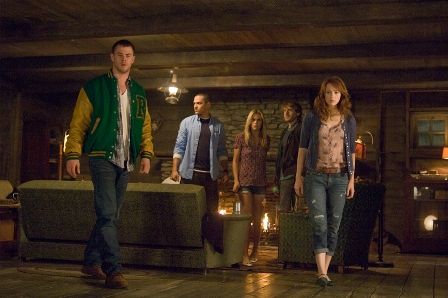 The Cabin in the Woods Photo credit: Lionsgate |
HOLLYWOODCHICAGO.COM: That was my next question — nothing has changed? If MGM doesn’t go down and this comes out two years, it’s exactly the same?
GODDARD: It is.
HOLLYWOODCHICAGO.COM: And it was never in 3-D? Two years ago, EVERY horror movie was in 3-D.
GODDARD: It had been in consideration and the studio was pushing it at one point. It was in that period where studios thought they could sprinkle 3-D fairy dust and make a movie successful. We had to have those conversations.
HOLLYWOODCHICAGO.COM: There was an especially nauseating time in horror when junk like “My Soul to Take” was getting converted.
GODDARD: Oh yeah. And we had to talk about it. Luckily, when we went to Lionsgate, we said, “We don’t want this in 3-D.” And they said, “We don’t either.”
HOLLYWOODCHICAGO.COM: Would you say you’re anti-3-D?
GODDARD: I love 3-D if it’s well done. I thought “Avatar” was beautiful. I’m anti-retro-conversion. I didn’t plan “Cabin” to be in 3-D. It’s WAY too dark to be in 3-D. It wouldn’t have worked. 3-D is like anything — it’s a good tool if used correctly.
HOLLYWOODCHICAGO.COM: Let’s talk about the inspiration for the movie. Where did it come from?
GODDARD: It was originally Joss’s idea. We had been talking a lot about horror films and wanting to make a horror film. They’re fun. Unlike some other genres, being low budget helps you. I don’t know many high-budget horror films that are…you know…
HOLLYWOODCHICAGO.COM: Any good.
GODDARD: Right. And we wanted to do something weird and I wanted to direct, so it would benefit us to keep our costs low. It wasn’t purely it. We just love horror movies. He had this basic idea — the “Upstairs, Downstairs” quality of “Cabin in the Woods.” And I just sparked to it right away. We just started talking about it. We just sat down to entertain each other. We didn’t pitch it. We just started working on it. We knew it was different. And so we knew that the more we could do ahead of time meant more that we could show the studio.
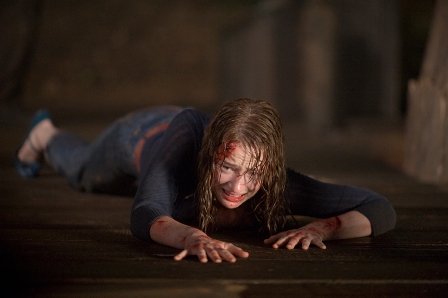 The Cabin in the Woods Photo credit: Lionsgate |
HOLLYWOODCHICAGO.COM: Did you bring any of your “Lost” experience to it? Without spoiling anything, there is a certain “Dharma Initiative quality” to what’s going on.
GODDARD: There is. I’m trying to think when we wrote this…I think it was season two. Maybe not. I don’t know. I’m me. It’s all part of the same bouillabaise.
HOLLYWOODCHICAGO.COM: Did you write for anyone? Richard Jenkins, Bradley Whitford, Amy Acker?
GODDARD: We wrote for Bradley and Richard. They were our first choices. Certainly, you can hear Bradley’s voice in there. So much so that I remember yelling at one point, “If Bradley Whitford doesn’t want to do this movie, I don’t want to make this movie!” I don’t know who else we’d cast.
HOLLYWOODCHICAGO.COM: What do they bring that other actors wouldn’t?
GODDARD: We ask a lot of our actors. The way we switch gears is not common. So you need to find actors that are comfortable doing that. Bradley is. “The West Wing” would switch from heartbreaking drama to the silliest comedy. I remember an episode with Bradley in fisherman pants debating national policy. And, Richard, I don’t know another actor who can go from “The Visitor” to the Farrelly Brothers movies he makes. He’s fearless. Both of ‘em. That’s sort of what we need because so much of this movie could be second guessed. We needed people willing to be different. It required a tremendous amount of faith in me.
HOLLYWOODCHICAGO.COM: They took a risk with a debut director. And there have been a lot of high-concept horror movies that totally stink.
GODDARD: That’s right. Exactly. And because so much of this movie hinges on tone and the only person that controls tone is me. So it requires all of my actors to have faith in me. We talked about that a lot. It’s crucial.
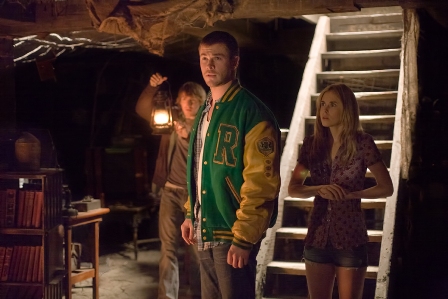 The Cabin in the Woods Photo credit: Lionsgate |
HOLLYWOODCHICAGO.COM: Let’s talk about the young actors. How did you find them? Open auditions?
GODDARD: Hundreds and hundreds of auditions. We found them all over the globe. It was a global search.
HOLLYWOODCHICAGO.COM: Let’s talk a little bit about when it’s done. I’ve heard concerns that the trailer gives too much away. Are you worried about that at all?
GODDARD: I have mixed feelings. As a filmmaker, I don’t want to do any trailers. And, in particular, the less you know about this the better. I know that. It is more fun the less you know. But we also have a responsibility to tell the audience that it’s worth your time. They need to know that we’re going to put on a show for them and we’re not going to give them the same old thing. And, so, it’s that balance. I do feel like the trailer does a great job. The truth is that even though the trailer gives some things away, we save SO MUCH.
HOLLYWOODCHICAGO.COM: I know. It’s actually a bait and switch. You go in thinking that you know everything and then…from the very opening scene!
GODDARD: That’s right. Because everything we think we gave away we give away in the first two minutes of the movie. So I’m not too concerned about it.
HOLLYWOODCHICAGO.COM: How does your TV background change this project? Would it have been different without it? Does it change the way you approach film?
GODDARD: I’m sure it does. How I don’t know. I think…the four shows I did were all fearless. They were not afraid. J.J.[Abrams], Joss [Whedon], and Damon [Lindelof] were not afraid to do something different; to take a risk. On all of those shows, I had to fight those battles with networks saying, “The audience isn’t going to understand this. This is too much.” All of them. Sometimes it was small things. Sometimes it was a season arc. You learn to believe. You learn to risks. And “Cabin” is definitely risky. We didn’t play it safe in this movie. I don’t think I would have done that if I didn’t have my TV experience. On those shows, almost every time we took a risk the audience came with us. Hollywood definitely underestimates the audience over and over and over and over. My experience has been the opposite.
HOLLYWOODCHICAGO.COM: I can see fights on “Alias” and “Angel” but they fought you on “Lost”?
GODDARD: Oh my God. The most fights of any show. There are problems that come with success. The more successful something gets, the more people get involved. “Lost” had the most fights.
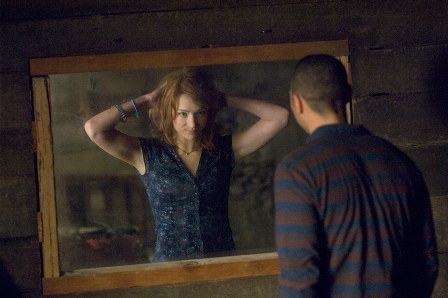 The Cabin in the Woods Photo credit: Lionsgate |
HOLLYWOODCHICAGO.COM: And you just pushed your way through.
GODDARD: Yes. It was a credit to Damon. I remember the very first season of “Lost,” they said, “You can’t have other people on the island. You will never have another plane crash. Any science fiction.” Damon had to fight every single one of those battles. It was a credit to him. They fought him on everything.
HOLLYWOODCHICAGO.COM: And the show worked BECAUSE of the risks.
GODDARD: Absolutely.
HOLLYWOODCHICAGO.COM: I remember the first Jin episode and I thought to myself, “I just watched a SUBTITLED episode of network television!”
GODDARD: That was a HUGE fight. It was a colossal fight. It was crazy. I remember the worry that the ratings would plummet that night.
HOLLYWOODCHICAGO.COM: Do you think things have gotten better or worse since you were deep in the heart of TV? There’s a part of me that worries that the landscape on the networks has changed enough even in the last decade that “Lost” wouldn’t work in 2012. They’re taking less risks.
GODDARD: I don’t know. That’s what created “Lost” in the first place. You just need those times where the petrie dish starts to get boring and then something interesting will grow out of it. Something will blow us all away. Although there are great shows on now.
HOLLYWOODCHICAGO.COM: There’s a few. Would you go back to TV?
GODDARD: Certainly. The thing that’s great about it is also what’s miserable about it — every eight days you have to put on a show. It’s wonderful because you don’t second guess yourself and you’re making product. There’s something that happens…because there’s only eight days, there’s only so much meddling. You have to make decisions. In the feature world, the deadlines are all fake. In TV, it’s real. It will be a black screen. You can move a film release date. Films take a long time.
HOLLYWOODCHICAGO.COM: Especially this one.
GODDARD: That’s right. There’s nothing about a feature to make you miss television,
HOLLYWOODCHICAGO.COM: Eight-day cycles to, what, three years on this film?
GODDARD: Right.
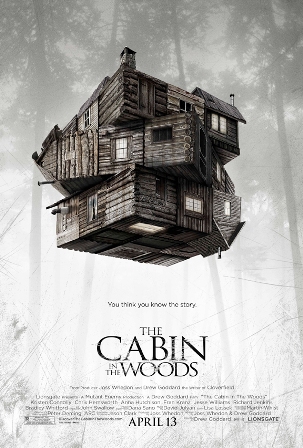 The Cabin in the Woods Photo credit: Lionsgate |
HOLLYWOODCHICAGO.COM: And I wonder…did you ever want to go back and tinker with it? Some people would have gone crazy in the editing booth.
GODDARD: I certainly did. Before we locked it, there were months when I was tinkering and driving anyone insane. But I was happy when we locked it. You do reach a point where you just have to walk away. And it’s easier to walk away when you don’t have any more money left.
HOLLYWOODCHICAGO.COM: I don’t want to spoil the music choices but there are two great ones, one an unexpected classic rock song and the closing credits tune — neither of which I’ll spoil. So, how do you choose the music?
GODDARD: There are things I didn’t want to do. I sort of knew that a hiatus was coming at MGM. So, first of all, I didn’t want anything that felt too current. I didn’t want The Black Eyed Peas or Kesha. And we got those demos. I didn’t want anything like that. And I wanted the movie to feel anachronistic. I wanted the time period to be unclear. And we didn’t have any money. Which makes you create. But I really wanted that song for the end of the movie. I just wrote a passionate letter. I was such a fan. I just laid out that “I love your work and here’s what this movie is and I’m happy to show it to you.” We still paid for it but he came back. It made me happy — when your idols come through for you.
HOLLYWOODCHICAGO.COM: Horror movies that you loved that inspired this?
GODDARD: You have to give credit to everything John Carpenter and Sam Raimi have done. They are the most important. “Hellraiser” is certainly there. In more recent times, I thought “The Descent” was a spectacular horror film. I really like “The Strangers.”
HOLLYWOODCHICAGO.COM: I did too.
GODDARD: No more movie has scared me more in the last twenty years. “Suspiria.” All of Argento. “Alien.” “Alien” is the BIG one.
See a new “big one” when “Cabin in the Woods” opens this Friday, April 13, 2012.
 | By BRIAN TALLERICO |


